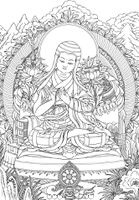Sa skya paN+Di ta: Difference between revisions
No edit summary |
No edit summary |
||
| Line 25: | Line 25: | ||
|ReligiousAffiliation=Sakya | |ReligiousAffiliation=Sakya | ||
|PersonalAffiliation=Grandson of [[Sa chen kun dga' snying po]] and nephew of [[rje btsun grags pa rgyal mtshan]] and [[bsod nams rtse mo]], and uncle of [[chos rgyal 'phags pa]]. | |PersonalAffiliation=Grandson of [[Sa chen kun dga' snying po]] and nephew of [[rje btsun grags pa rgyal mtshan]] and [[bsod nams rtse mo]], and uncle of [[chos rgyal 'phags pa]]. | ||
|StudentOf= | |StudentOf=Śākyaśrībhadra; rje btsun grags pa rgyal mtshan; | ||
|TeacherOf=gu ru chos kyi dbang phyug; chos rgyal 'phags pa; yang dgon pa rgyal mtshan dpal; lho pa kun mkhyen rin chen dpal | |TeacherOf=gu ru chos kyi dbang phyug; chos rgyal 'phags pa; yang dgon pa rgyal mtshan dpal; lho pa kun mkhyen rin chen dpal | ||
|BdrcLink=https://www.tbrc.org/#!rid=P1056 | |BdrcLink=https://www.tbrc.org/#!rid=P1056 | ||
Latest revision as of 14:52, 10 July 2020
| PersonType | Category:Classical Tibetan Authors |
|---|---|
| MainNamePhon | Sakya Paṇḍita |
| MainNameTib | ས་སྐྱ་པཎྜི་ཏ་ |
| MainNameWylie | sa skya paN+Di ta |
| SortName | Sakya Paṇḍita |
| AltNamesTib | ཀུན་དགའ་རྒྱལ་མཚན་ · ས་སྐྱ་པཎྜི་ཏ་ཀུན་དགའ་རྒྱལ་མཚན་ |
| AltNamesWylie | kun dga' rgyal mtshan · sa skya paN+Di ta kun dga' rgyal mtshan |
| AltNamesOther | Sapaṇ · Sapen · Sapan |
| YearBirth | 1182 |
| YearDeath | 1251 |
| TibDateGender | Male |
| TibDateElement | Water |
| TibDateAnimal | Tiger |
| TibDateRabjung | 3 |
| TibDateDeathGender | Female |
| TibDateDeathElement | Iron |
| TibDateDeathAnimal | Pig |
| TibDateDeathRabjung | 4 |
| ReligiousAffiliation | Sakya |
| PersonalAffiliation | Grandson of Sachen Kunga Nyingpo and nephew of rje btsun grags pa rgyal mtshan and bsod nams rtse mo, and uncle of chos rgyal 'phags pa. |
| StudentOf | Śākyaśrībhadra · rje btsun grags pa rgyal mtshan |
| TeacherOf | gu ru chos kyi dbang phyug · chos rgyal 'phags pa · yang dgon pa rgyal mtshan dpal · lho pa kun mkhyen rin chen dpal |
| BDRC | https://www.tbrc.org/#!rid=P1056 |
| Treasury of Lives | http://treasuryoflives.org/biographies/view/Sakya-Pan%E1%B8%8Dita-Kunga-Gyeltsen/2137 |
| Himalayan Art Resources | https://www.himalayanart.org/search/set.cfm?setID=325 |
| IsInGyatsa | No |
| PosBuNayDefProv | Provisional |
| PosBuNayDefProvNotes |
|
| PosAllBuddha | Qualified No |
| PosAllBuddhaNote | There is some discrepancy between Sapen's use of the term tathāgata-essence and buddha-nature and other thinkers that use these terms synonymously. In Sapen's view, sentient beings do not possess the former, but do possess a more general form of the latter. So while the answer is a qualified "no" in terms of the more general debate on this issue and the way others have addressed it and asserted Sapen's position, strictly speaking from Sapen's view the answer could more accurately be a qualified "yes" as he does state all beings have a basic "inherent" buddha-nature, though this does not correspond to an essence that is endowed with enlightened qualities. The tricky issue being the equivalency of these terms tathāgata-essence and buddha-nature and the perception of the Sakya position by later authors. |
| PosAllBuddhaMoreNotes |
|
| PosYogaMadhya | Madhyamaka |
| PosZhenRang | Rangtong |
| PosZhenRangNotes | He predates the distinction but is clearly in line with the rangtong perspective. |
| PosAnalyticMedit | Analytic Tradition |
| PosEmptyLumin | Tathāgatagarbha as the Emptiness That is a Non-implicative Negation (without enlightened qualities) |
| PosEmptyLuminNotes | "An opinion shared by rNgog and Sapan is that Buddha-nature should be understood in the sense of emptiness. The difference is that rNgog directly equates Buddha-nature with emptiness, whereas Sapan regards the intentional ground (dgongs gzhi) of Buddha-nature to be emptiness." Kazuo Kano, Buddha-Nature and Emptiness, pp. 309-310. |
| PosSvataPrasa | Prāsaṅgika (ཐལ་འགྱུར་) |
| Other wikis |
If the page does not yet exist on the remote wiki, you can paste the tag |

